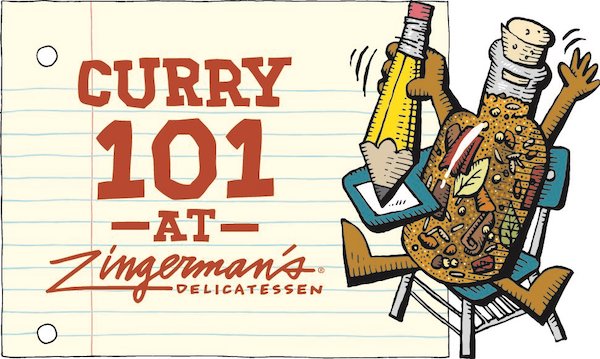The origin of the word “curry” is like the story of “kangaroo”—it’s based on a British misunderstanding. Historians suggest that a few centuries ago the Tamil word kari referred to a spiced sauce or to black pepper. British colonizers took that term, anglicized it to “curry,” and used it to describe a wide range of dishes eaten across the Indian subcontinent. It’s worth noting that even today Indian don’t use the word “curry” much, unless they’re speaking to an English speaker. Instead, they use the names of specific dishes, like korma, rogan josh, or vindaloo. It’s a little like if visitors to the US used the word “soup” to refer to all chilis, chowders, and consommés—it’s not exactly wrong, but we usually use the more specific names.
Today, in English, we use the word curry to refer to spiced stews of meat, fish, or vegetables, generally eaten with rice or bread. Homegrown curry recipes are common all around the globe: from India to the Caribbean, from Tanzania to Japan, from Thailand to the UK.
The story of how curries became so ubiquitous is the story of 2,500 years of human movement around the globe.
Around the 4th century BCE, merchants and missionaries from India traveled across southeast Asia, bringing tamarind, garlic, shallots, ginger, turmeric, and black pepper along with Hinduism and Buddhism. In the 8th century CE, Arab merchants and missionaries traveled throughout India and southeast Asia, bringing dishes including kebabs, biryanis, and kormas, along with Islam. Starting around the turn of the 16th century, European merchants, missionaries, and colonizers began establishing forts and trading posts in India and across southeast Asia. In addition to Christianity, they brought new foods from the Americas, including potatoes, tomatoes, and most significantly, chili peppers. Over the centuries, all these ingredients and techniques contributed to the development of new dishes across southeast Asia—the same dishes the Brits would later group together under the moniker “curry.”
After the British empire outlawed slavery in 1833, former slaves left their plantations. To address the labor shortage, Brits recruited Indian indentured servants. After five to ten years of hard labor for minimal wages, the Indians were given “free” land in their new countries. Under this system, 1.5 million Indians emigrated to other parts of the British empire, settling everywhere from Fiji to South Africa to Trinidad and Tobago. Over time, new curries developed as the Indian immigrant communities began cooking with new local ingredients.
Of course, curries came to Britain, too.
In 1784 the first commercially available curry powder was manufactured and sold by Sorlie’s Perfumery Warehouse, just down the block from Piccadilly Circus in London. By the mid-19th century, curries were regular features in British cookbooks, and frequently served in cafes and clubs. They still are.
Curry powder made its own conquests around the world, showing up today in everything from curried chicken salad in the US, to currywurst sausages in Germany, to curried scallop pie in Tasmania, to curried herring in Scandinavia. But perhaps the unlikeliest and yet most fervent love for curry powder comes from Japan. In 1868, when Japan opened their ports to foreigners, British sailors brought foods including ice cream, beef hash, and curry powder. Today, curries are a Japanese schoolkid favorite.

